A good set of kitchen towels is a must-have in every home. An excellent kitchen towel, on the other hand, does not become a limp wet lump after drying a few dishes. When shopping for quality, there are a few things to remember.
Homeowners may be concerned about having enough kitchen towels on hand. Many people question if there is an exact or perfect amount to ensure that your kitchen is well-managed.
How Many Kitchen Towels are Needed?
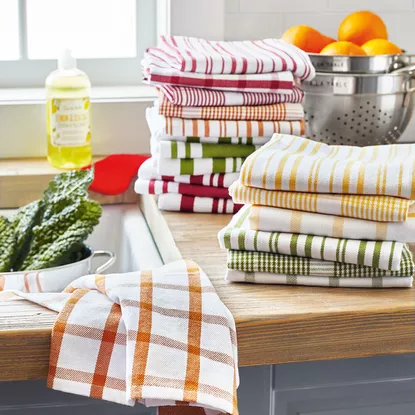
So, how many dish towels are you going to need? It’s impossible to have too many. You want enough so that there are always a few in the wash. Using a soiled towel to clean is not a good idea.
A minimum of two dozen is more than sufficient. It’s always a good notion to have extras. These towels serve a variety of functions as well.
◉ Hand Towels
Every kitchen must have lots of hand towels. Also, because you dry your hands so frequently during the day, it’s a good thought to substitute your kitchen hand towel regularly.
Hand towels may be useful for more than just wiping your hands; they can also be used to dry and polish dishes, so keep a selection on hand at all times.
◉ Dish Towels
Dishcloths are also a must-have in the kitchen. Terrycloth washcloths are the ideal option for cleaning up spills and washing dishes.
◉ Bar Mops
In the kitchen, bar mops are essential for wiping down countertops and cleaning up spills. For convenient access, keep a stack beneath your sink or in a drawer.
◉ Wrap for Produce
If you run out of storage bags and need to utilize some greens or herbs soon, wash them and roll them up in a dishtowel before storing them in the refrigerator.
◉ Pot Holders
When lifting a pot lid or removing something out of the oven, a towel generally comes in handy if it’s within reach. It’s handy to have one around to assist you to hold pots that are too hot to grasp with your bare hands.
◉ Decoration
The lovely ones hang from the oven door handle and give a splash of color to a drab kitchen. This is an excellent accent piece for making your kitchen stand out.
Materials Used in the Production of Kitchen Towels
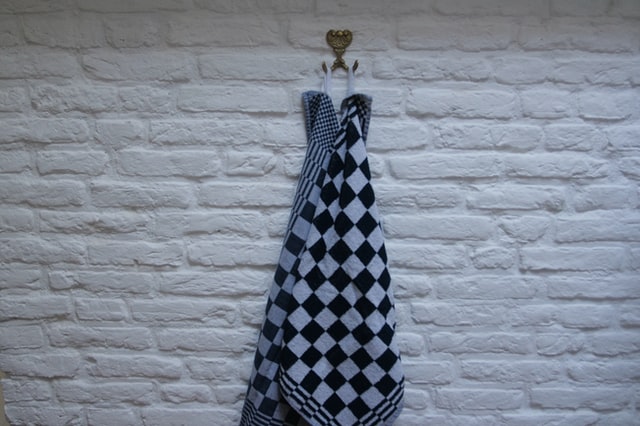
Kitchen towel sets are superior to paper towels in terms of absorbency, cost-effectiveness, and environmental friendliness. They may be used to embellish your kitchen.
◍ Linen
This is comprised of thin cotton and is popular for its lint-free qualities. Linen, in its most basic form, is food-safe and the recommended material for wrapping baked goods.
Linen sets, particularly pristine white ones, are also popular for décor, whereas rougher towels are employed for heavy-duty cleaning.
◍ Ribbed Cotton
It is linen’s thicker, more densely woven relative. Its weave is generally harsher; its coarseness is ideal for dishwashing that requires some scrubbing.
Ribbed cotton is also a favored choice for gripping hot pot handles and wiping the surface.
◍ Terry Cloth
Terry cloth towels are popular for rapid drying and excellent surface cleaning due to their outstanding absorbent characteristics. They may be used as trivets when folded or piled.
Terry fabric is used in a variety of culinary goods due to its versatility, including potholders and oven mitts.
◍ Eco-Friendly Blends
A variety of ecologically friendly textile combinations are currently utilized for kitchen towel sets.
Bamboo, wood, cellulose, and recycled fibers are common in these mixes, which are generally blended with cotton to improve absorbency.
◍ Microfiber
It is a synthetic substance that is well recognized for its cleaning qualities. It’s ideal for dusting and cleaning since it’s made up of hundreds of small, tightly-packed fibers.
Best of all, microfiber cleans without harming surfaces, including fragile glass.
Things you can Do with your Kitchen Towels
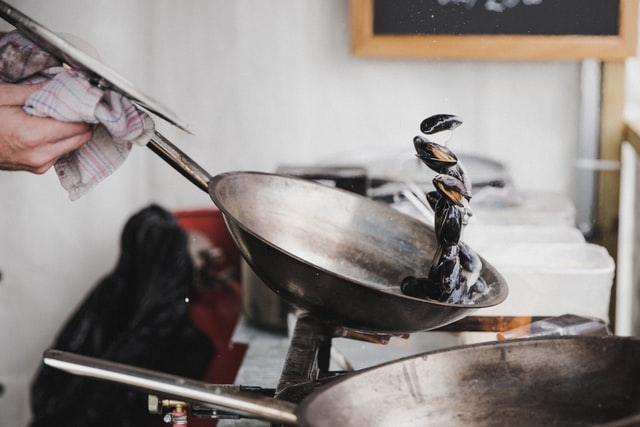
It’s used for more than merely drying your hands. Your standard kitchen towel may be one of the most adaptable items in your arsenal.
You wouldn’t think a small piece of fabric could have such a large influence, yet there are a surprising amount of kitchen towel applications.
✔ It is used to Wave Smoke to the Smoke Detector
This may sound strange, but anybody who has set off a smoke alarm knows how irritating that noise is. By waving a kitchen towel below it, you can get it to shut off faster.
✔ Prevent your Cutting Board from Slipping Around
Every chef uses a moist towel below their cutting board, which is the restaurant industry’s best-kept secret. It stops the board from sliding about, allowing you to concentrate on your knife skills while chopping your vegetables.
✔ It is used as a Potholder
Fold the towel over itself a couple of times and you have a potholder that works just as well as any other. Just ensure the towel is completely dry before grabbing the hot pan.
Heat will transmit through a moist towel, as I discovered the hard way.
✔ It may be used to Wring out Watery Vegetables
The trick to preparing delicious hash browns is to start with super-dry potatoes. A strong kitchen towel is the finest method to wring out those potatoes.
Simply pile the shredded veggies in the middle of the towel, pull the edges to the middle, and wring until you can no longer twist.
✔ A Cheesecloth Substitute
If you don’t have any cheesecloth on hand, a kitchen towel will suffice. You may strain the yogurt and create Greek yogurt with it or you can strain the aromatics out of your stock by pouring it directly through the cloth.
Wring it out and chuck it in the washing machine when you’re through.
✔ Easier Whisking
Put a kitchen towel under your mixing bowls, just as we did with our cutting board. You won’t have to deal with the bother of a slipping bowl. It’s very useful for whipping egg whites to stiff peaks.
✔ Avoid Scorch Marks on Your Table
If you don’t have a trivet, an ordinary kitchen towel will suffice. Simply fold the towel twice over itself to produce a nice square. Then, position it beneath your hot casserole dishes.
✔ Maintain the Freshness of Your Herbs
This is the most effective method for preventing herbs and fragile greens from turning limp in the refrigerator. Simply clean them, clip off the base of the stems, and wrap them in a moist dishtowel.
They will keep fresh in the crisper drawer for three to four weeks.
✔ Dry your Vegetables
If you don’t have enough space to store a large salad spinner, use a kitchen towel instead. Place your greens in the middle of a towel after washing them, and put the edges to the center.
Gently shake and spin the cloth to drain excess water without crushing the greens.
✔ While Peeling beets, Keep your Hands Safe
This one will most likely stain your towel crimson, but it will keep your hands stain-free. Cook the beets in their skins rather than peeling them. The skins should then be removed with a cloth. They’ll just fall off boiling or cooked beets.
✔ Maintain Food Warmth
Instead of using aluminum foil for cooking in foil packets, use a reusable towel to keep your meal warm. To protect biscuits or bread from getting cold, simply put a clean kitchen towel over them.
When holding a backyard BBQ, it’s also a wonderful method to keep mosquitoes off the food.
What should you Look for in a Kitchen Towel?
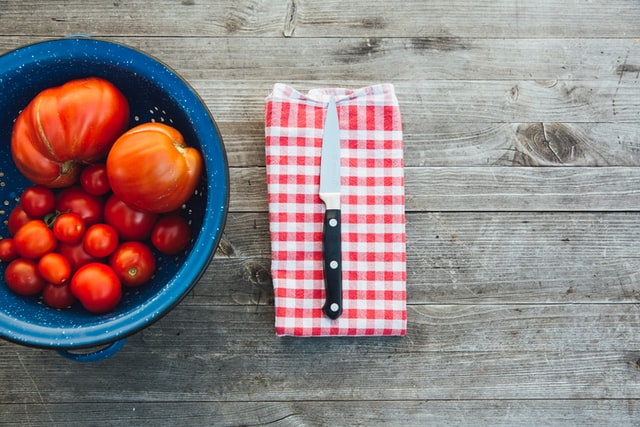
When it comes to purchasing a kitchen towel, there are several possibilities. There are certain aspects to consider while looking for a nice kitchen towel.
It is critical to understand what components to search for to make your purchase worthwhile.
!The Size
The size of the kitchen towel is critical. A kitchen towel should be large enough to fold in for numerous usage. The bigger the towel, the more surface areas there are to deal with.
!The Material
Cotton kitchen towels are ideal for drying and cleaning since they are lint-free and absorbent. It absorbs all of the messes. Always search for towels that are thick, silky, and well-hemmed.
!The Density
Thick towels are more absorbent and last longer than thin towels, which do not absorb as much liquor.
!The Style
Everything now has a style. Kitchen towels come in a variety of styles, including plain, checkered, striped, double lining, and many more that are pleasing to the eye and look wonderful in your kitchen.
!The Color
Previously, kitchen towels were only available in plain white, but today they are available in a variety of monochromatic colors and designs.
How to Clean Kitchen Towels Correctly
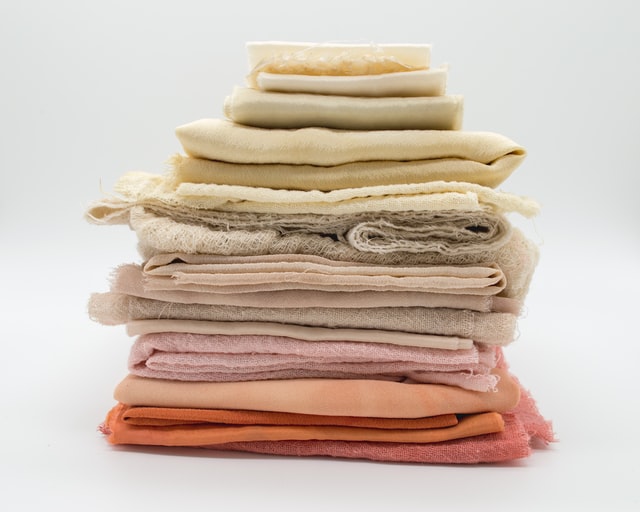
You don’t want your towels to get discolored or stinky from constant use. When washing your kitchen towels, it’s critical to follow a strict cleaning program to avoid mildew and contamination.
With the right procedure, you can remove filth and food particles from towels.
˃ Air Dry
Wet kitchen towels in the bottom of a laundry hamper can stink and could infect other objects. And because they might be heavy with water and other liquids, it’s best to hang them to dry before beginning a wash cycle.
The towels may be kept in good condition by circulating them on a laundry line or drying rack.
˃ Leave out the Fabric Softener
When using towels for deep cleaning and drying, a thorough cleaning is required. Fabric softener reduces the effectiveness of kitchen towels by forming a barrier on the fibers.
Coating the filaments reduces their absorbency, so avoid using fabric softener in your kitchen towel loads.
˃ Use Vinegar
Kitchen hygiene is essential for running a dependable restaurant, and towels must also follow certain criteria. Particles might accumulate on your towels, but vinegar is an effective cleaner.
For its helpful acidity, vinegar dissolves the accumulation on kitchen towels.
˃ Hot Water
When it comes to germ elimination, heat is your friend, and adjusting your washing cycle water to hot may completely clean towels.
Since your kitchen towels are subjected to a lot of wear and tear over the day, a heavy-duty procedure is recommended.
˃ Wash it Alone
Since tablecloths, uniforms, and towels dry and clean at different rates, it’s best to wash them in separate loads of laundry.
Towels also produce a significant amount of lint, which contaminates other materials. To keep them strong, just use kitchen towels in the wash.
˃ Stains Should Be Spot-Treated
Swiping up soy sauce or marinara sauce may stain your kitchen towels. When you have unattractive markings on your towels, especially multi-use towels, they might take on a dreary appearance.
To target the obstinate blotches, spot-treat these stains before washing clothes. Beverage and food stains can be removed using store-bought stain removers, but they require different water temperatures.
Frequently Asked Questions
Q: What kitchen towels do I require?
A: As they all serve various functions, you usually require four different kitchen towels made of different fabrics.
Q: How often should you change your kitchen towels?
A: You should replace your kitchen towels at least once a week, ideally every few days, to help avoid the spread of germs.
Q: How many dish towels would you require?
A: Use more than one dishcloth every day if necessary. You’ll need a fresh cloth if you’ve cleaned two sinks worth of dishes.
Q: How big are kitchen towels?
A: Most all-purpose cotton kitchen towels appear to be 20 by 30 inches in size, give or take.
Q: What type of kitchen towels are used by chefs?
A: Chefs want towels that are densely woven for intensive kitchen use. This not only makes them more durable, but it also makes them lint-free.
Final Thoughts
Towels in the kitchen are frequently ignored. Investing in high-quality ones will ensure that you operate successfully in your kitchen. Having an excess of it will allow you to have extras when needed.
You may also convey your personality through your kitchen towels. Every kitchen should have at least two dozen kitchen towels. Every kitchen towel has a unique role in keeping your cooking experience clean and efficient.
